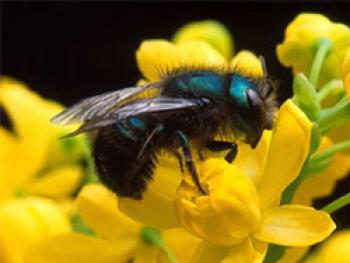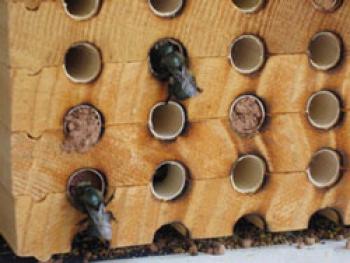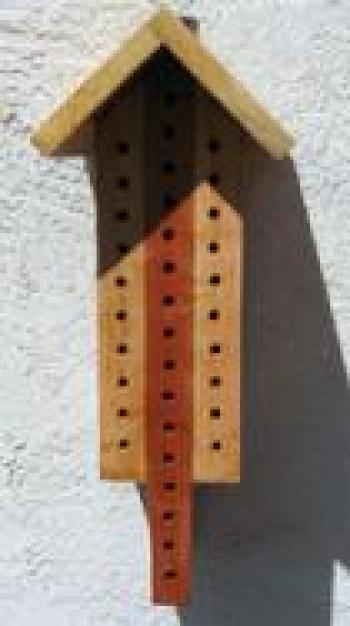Contact
Assistant Professor of Apiculture & Urban Entomology
Phone: 501-671-2222
Fax: 501-671-2252
Email: jzawislak@uada.edu
Web: uaex.uada.edu/bees
University of Arkansas System
Division of Agriculture
Cooperative Extension Service
2601 N. Young Ave.
Fayetteville, AR 72704
Native bees in Arkansas
The European honeybee is not native to Arkansas. However, many native bee species work to pollinate crops and plants in our state so you don't have to be a beekeeper to encourage bees in your yard.
Solitary bees make great pollinators.
Unlike honey bees, they do not live in large colonies, don't produce honey and they do not sting. They are important pollinators of wildflowers across North America. Because they tend to forage in the area near their nests (usually within 500 yards), they can serve as efficient pollinators of small gardens and orchards. Many solitary bees nest in the ground, but bees in the family Megachilidae seek cavities in dead wood in which to build their solitary nests. These nests are provisioned with pollen and nectar, eggs are deposited, and then they are sealed off and abandoned. After overwintering as pupae, the adult adult bees will emerge from the holes in early spring and begin to forage. Male bees will die shortly after mating. Female bees will soon seek a cavity in which to to prepare their own nest. They will often remain in the vicinity of the nest from which they emerged. By providing numerous nesting blocks near garden spots or orchards, solitary bees can be encouraged to remain and reproduce year after year.
What types of bees help pollination?
Bees in the diverse family Megachilidae include the mason bees and leafcutter bees. These bees lack a pollen basket on their hind legs, as honey bees have. Instead, they carry pollen on the underside of their abdomen.
At least 40 species of bees in this family can be found in Arkansas.
All will seek out cavities in which to dwell, and can be encouraged as pollinators by providing them with suitable habitats. Leafcutter bees use their sharp mandibles to cut circles from plant leaves with which to line their nesting holes. They are sometimes considered a pest by gardeners because of aesthetic damage to ornamental plants, but they rarely remove enough leaf material to damage plant health. Mason bees get their name from the way they seal their nesting holes with mud after eggs have been laid in the provisioned cells. Many of these bees are excellent early season pollinators of fruit trees and garden vegetables. If you want to encourage mason bees for pollination, be sure there is a source of mud nearby, such as a stream or pond, or you may need to provide them with a source through irrigation.
|
|
|
|
Megachilid bees do not bore their own nesting holes, but are opportunistic house-hunters. Suitable nesting blocks can be easily built by drilling holes in practically any piece of untreated wood. Different species prefer hole diameters ranging from one-quarter of an inch to three-eighths of an inch, and spaced at least three-quarters of an inch apart. Blue orchard bees are prefer hole diameters of five-sixteenths of an inch. You can experiment with different sized holes, in increments of one-sixteenth of an inch, and see which ones appear to attract the most bees in your area. Holes should be three to five inches deep, and should not be drilled all the way through the wood. Bees will lay male eggs toward the front of the hole, and female eggs behind them. Deeper holes will accommodate more female bees, and therefore increase the number of pollinators for next season.
Create nesting blocks to encourage native bees.
Sections of hollow bamboo or cane can also be bundled together to provide solitary bee nests. Some people use paper tubes or straws to line the nesting holes, so that they can be removed and the blocks can be cleaned. Occasionally solitary wasps will also take up residence in these holes, but are rarely a problem, and may also contribute to pest control and pollination.
- These nesting blocks can be placed around an area to attract bees, and moved to a new area (such as an orchard or garden) before the spring emergence to encourage pollination.
- Nesting blocks should face the morning sun, and be sheltered somewhat from rain, either by adding an overhanging "roof" to keep rain from soaking the wood, or placing the blocks under the eaves of a barn or shed.
- Blocks containing dormant pupae can be brought into a shed or barn to protect them extreme cold during the winter, and placed outside again in early spring for pollination.
Read more about how solitary bees may play a bigger role in pollination than previously thought.
Native Megachilid bees of Arkansas |
|||
|---|---|---|---|
| Anthidium maculifrons | Coelioxys texana | Lithurgus gibbosus | Megachile petulans |
| Anthidiellum notatum | Dianthidium subrufulum | Megachile albitarsis | Megachile perihirta |
| Ashmeadiella bucconis | Heriades carnita | Megachile brevis | Megachile pollicaris |
| Coelioxys asteris | Heriades variolosa | Megachile campanulae | Megachile rugifrons |
| Coelioxys edita | Heterathidium ridingsi | Megachile concinna | Megachile texana |
| Coelioxys germana | Heterostelis australis | Megachile exilis | Osmia georgica |
| Coelioxys hunteri | Hoplitis cylindrica | Megachile georgica | Osmia lignaria |
| Coelioxys modesta | Hoplitis pilosifrons | Megachile inimica | Osmia subfasciata |
| Coelioxys octodentata | Hoplitis producta | Megachile mendica | Stelis costalis |
| Coelioxys sayi | Hoplitis truncata | Megachile parallela | Stelis lateralis |
Read more about native bees in Arkanasas.
Learn how to help bees find water to stay cool.


